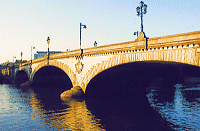|
A river crossing and station located where the Thames makes the first northward loop on its journey through London. The name
is not much used for the station’s hinterland, largely because Kew itself is on the opposite bank. Until 1759 a horse-ferry
carried traffic across the river near here, owned for the last century of its existence by the Tunstall family, who also had
a Brentford limekiln business. The entrepreneurial Robert Tunstall commissioned the building of a wooden toll-bridge, which
lasted thirty years before his son, also Robert, replaced it with a stone structure. The present bridge was designed by John
Wolfe-Barry and opened in 1903 by Edward VII, in whose honour it was named, although its users continued to call it Kew Bridge.
The construction of the bridge, in concrete and granite, was a joint project by the county councils of Surrey and Middlesex.
Kew Bridge station, on the Hounslow loop line, opened in 1850. In 1869 the London and South Western Railway Company built
Kew Railway Bridge at Strand on the Green to provide a shorter route for their line to Richmond.
A gem among London’s lesser-known collections, Kew Bridge Steam Museum is housed in a former water pumping station on
Green Dragon Lane. The museum has a narrow gauge steam railway, an exhibition on the story of London’s water supply
and the world’s largest collection of steam pumping engines, several of which can be seen in action at weekends.
 |

